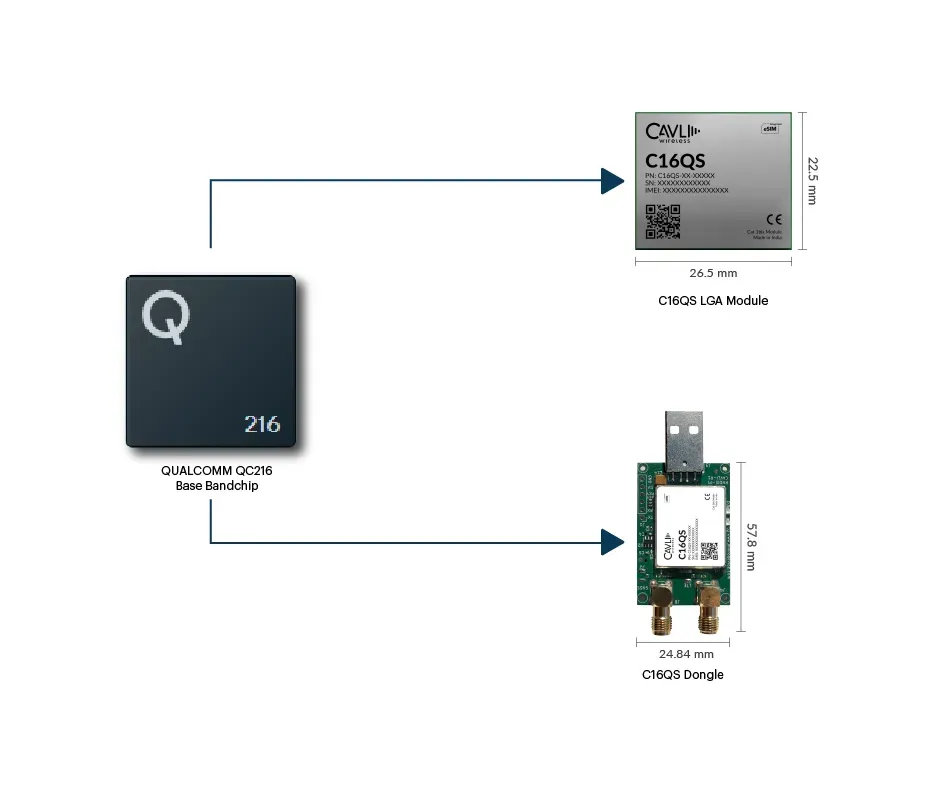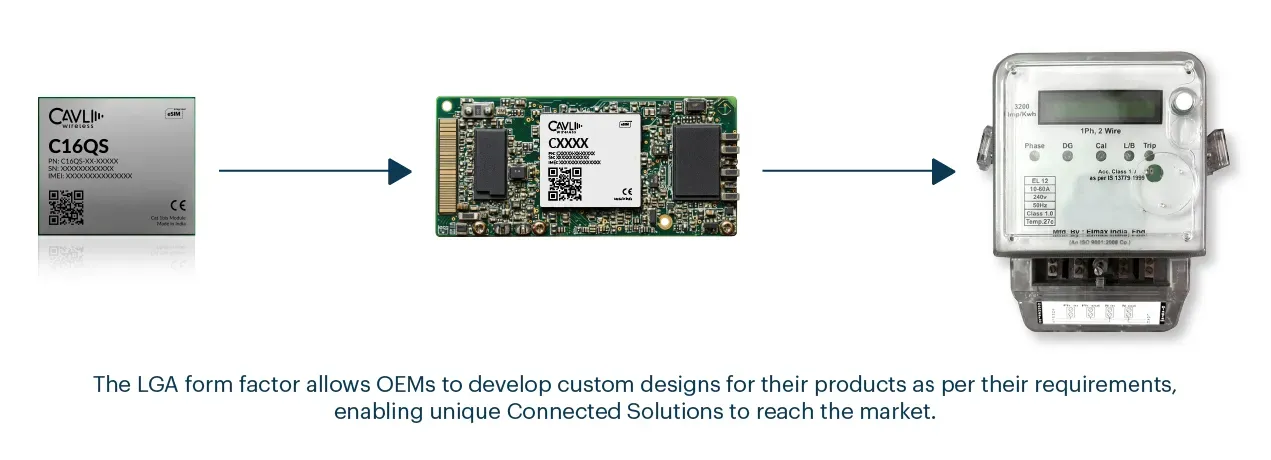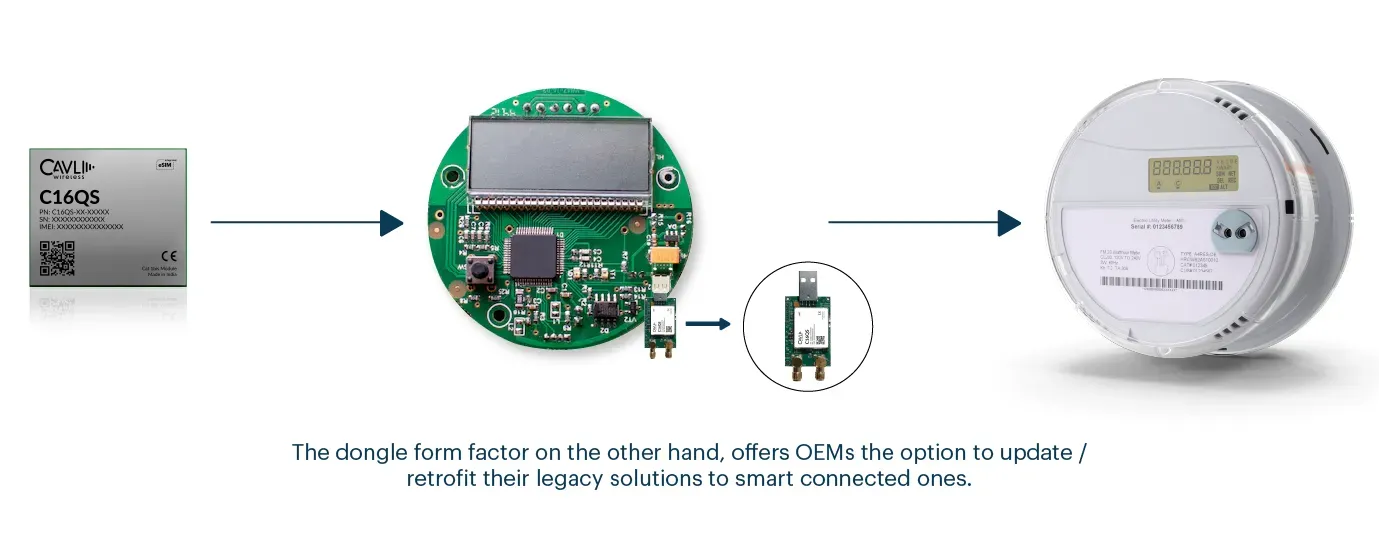In the evolving landscape of IoT, connectivity is no longer a luxury but a necessity. However, the journey to connect devices—both modern and legacy—comes with unique challenges. For IoT OEMs, the integration of connectivity often requires striking a balance between custom hardware designs and plug-and-play solutions that support legacy systems. This duality presents a critical hurdle: how to deliver connectivity solutions that cater to a diverse array of end-user scenarios without compromising on functionality or adaptability.
Cavli Wireless addresses this challenge head-on with the C16QS Cellular IoT Module, a versatile LTE Cat 1bis module that embodies Cavli's commitment to innovation. By offering the module in two distinct form factors—LGA (Land Grid Array) and USB Dongle—Cavli has effectively created a solution for both ends of the IoT spectrum, ensuring seamless integration across various applications.
The C16QS Module: A Glimpse into Versatility
The C16QS module, built on the Qualcomm QCX216 chipset, delivers efficient and reliable low-power LTE Cat 1bis connectivity. Key specifications include:
- Radio Category: LTE Cat 1bis
- Processor Core: Arm Cortex M3 up to 204MHz
- Operating System: FreeRTOS
- Memory: 1.25MB RAM + 4MB ROM
- GNSS Capability: L1 (GPS/BeiDou)
- eSIM Capability: Yes
These features make the C16QS an ideal candidate for IoT and M2M applications like smart metering, asset tracking, and POS systems. However, the true innovation lies in its availability in two form factors—LGA and USB Dongle—each uniquely designed to meet specific end-user and OEM requirements.
Form factors are pivotal in defining how an IoT module integrates into systems, balancing design complexity, flexibility, and ease of deployment. As per the purview of this blog, let us take a closer look at LGA (Land Grid Array) and USB Dongle form factors, each catering to distinct use cases and end-user requirements.
The LGA form factor emerged in the 1980s as a high-density packaging solution for ICs, particularly CPUs. Designed for direct soldering onto custom PCBs, LGA provides a compact footprint with minimal power loss. For IoT, its strength lies in enabling OEMs to design bespoke hardware tailored to specific applications like smart meters, industrial automation, or compact wearables. LGA modules support precise thermal management and scalability, making them ideal for high-performance, space-constrained deployments.
The USB Dongle tech evolved from the USB interface, introduced in the mid-1990s as a universal connectivity standard. USB Dongles gained popularity in the early 2000s for their portability and plug-and-play convenience, becoming a household name since the advent of WiFi Dongles and USB Dongle Modems. For IoT, USB Dongle modules eliminate the need for custom PCB design, providing instant connectivity to modern and legacy systems via a standard USB port. This makes them invaluable for retrofitting applications like upgrading legacy machinery, vending machines, or older vehicle systems to modern IoT capabilities.
While LGA prioritizes compact, integrated designs for optimized performance, USB Dongles champion versatility and quick deployment, bridging the gap between legacy and future-ready systems.
The EDGE Feature: Dual Form Factors for Tailored Connectivity
LGA Form Factor: Precision for OEMs
The LGA variant is a favorite among OEMs looking to design custom solutions. By integrating the C16QS module directly onto a PCB, OEMs gain granular control over the device's hardware design, optimizing power usage, size, and performance. This approach works best for applications where scalability, compactness, and integration are crucial, such as smart metering or industrial automation.

USB Dongle Form Factor: Plug-and-Play for Legacy Systems
The USB Dongle form factor, on the other hand, transforms the C16QS module into a plug-and-play device. Designed to interface seamlessly with any system equipped with a USB port, the dongle eliminates the need for custom PCB designs, making it ideal for retrofitting legacy systems. Whether it is upgrading old vending machines or connecting legacy industrial equipment, this USB based wireless dongle brings IoT connectivity to systems that would otherwise be excluded from the IoT revolution.
Engineering Implications: Bridging the Gap for OEMs
For OEMs, the dual form factor design of the C16QS module introduces significant engineering benefits:
- Custom Design Freedom with LGA: OEMs have the flexibility to design bespoke PCBs tailored to specific applications. For instance, an energy metering company can create compact devices optimized for ultra-low power consumption by embedding the LGA variant directly onto their PCB. The module’s 1.25MB RAM and FreeRTOS environment make it perfect for lightweight, power-efficient applications.
- Quick Deployment with USB Dongle: The USB Dongle variant eliminates the need for hardware redesign, enabling OEMs to quickly bring IoT functionality to legacy devices. A factory deploying legacy machinery can easily integrate the wireless dongle into existing systems, ensuring they remain competitive without the need for costly hardware upgrades.

Think of the C16QS module as a tailor’s toolkit for connectivity. The LGA variant is like a custom-tailored suit—designed from scratch to fit specific needs and ensure the perfect fit. It’s ideal for those who want complete control over the final product.
Practical Implications: Benefits for End Users
For end users, the dual form factor capability of the C16QS module translates to tangible benefits:
Empowering Legacy Systems
Imagine a fleet of delivery trucks using legacy GPS trackers that are no longer compatible with modern connectivity standards. By integrating the USB Dongle variant of the C16QS, the fleet manager can enable LTE connectivity without replacing the entire system, reducing costs and downtime. This plug-and-play functionality ensures that legacy devices are not left behind in the connectivity revolution.
Enabling Smart Retrofits
Consider a city upgrading its aging parking meters. Instead of replacing every meter with a new smart system, the municipality can retrofit existing units with the USB Dongle form of the C16QS module. This approach saves time and resources while delivering modern features like real-time data collection and wireless payments.
Streamlined Modern Solutions
For users of new IoT applications, the LGA variant ensures compact and efficient designs. For example, in precision agriculture, embedded C16QS modules can power lightweight, solar-powered sensors that provide real-time data on soil moisture and weather conditions, enabling smarter irrigation.

The USB Dongle, however, is like an off-the-shelf accessory—ready to wear and easy to pair with any outfit, regardless of style. It provides instant functionality without the need for custom alterations, making it the perfect choice for those looking to enhance existing systems.
Closing Thoughts: Redefining Versatility in IoT
In the world of IoT, one size does not fit all. Cavli’s C16QS module, with its dual form factor capability, demonstrates that adaptability is the key to unlocking the full potential of connected solutions. By bridging the gap between custom designs and plug-and-play functionality, the C16QS empowers industries to achieve seamless connectivity, regardless of their starting point.
With integrated eSIM capability and support for Cavli’s proprietary Hubble platform, the C16QS module offers seamless device and connectivity management across both form factors. This unified ecosystem streamlines global deployments, allowing businesses to focus on innovation rather than troubleshooting connectivity challenges.


